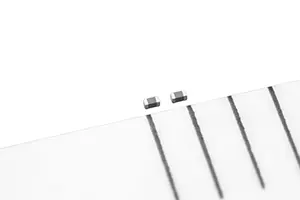source: TDK news
TDK Corporation announced the development of the MMZ0402EUC series of chip beads, with the lowest DC resistance for a chip bead its size*.
The two new types with their respective impedance values of 150 Ω and 180 Ω at 100 MHz, feature DC resistance values of only 0.62 Ω and 0.69 Ω. This results in a significant reduction in power losses, while at the same time providing excellent noise suppression. In fact, the compact IEC 0402 components with dimensions of 0.4 mm x 0.2 mm x 0.2 mm feature an impedance that is up to 20 percent higher than TDK’s existing MMZ chip beads with the same DC resistance rating. Combined with their higher rated currents of 350 mA and 300 mA compared to existing types, the new MMZ0402EUC chip beads are ideally suited for noise suppression in the power and signal circuits of smartphones, tablets and other mobile devices. Mass production was launched in August 2017.
The improved ratio of impedance to DC resistance of the new series was achieved thanks to advanced TDK materials. The components can be used in a wide range of temperatures from -55 °C to +125 °C. TDK will continue to expand the available range of impedance values in the compact lineup to meet the requirements for a broad range of mobile device designs.
* As of August 2017, according to TDK research
Main applications
- Smartphones, tablets, and other mobile devices
Main features and benefits
- Lowest DC resistance for a chip bead of its size, with values as low as 0.62 Ω
- Impedance of 150 Ω and 180 Ω at 100 MHz is up to 20 percent higher than that of existing chip beads with the same DC resistance
- Compact dimensions of just 0.4 mm x 0.2 mm x 0.2 mm
- Wide operating temperature range from -55 °C to +125 °C
Key data
-
Type Dimensions
[mm]Impedance
[Ω] at 100 MHz typ.*Impedance
[Ω] at 700 MHz typ.*DC resistance
[Ω] max.Rated current
[mA] max.MMZ0402EUC151C 0.4 x 0.2 x 0.2 150 340 0.62 350 MMZ0402EUC181C 180 400 0.69 300 * Tolerance ±25%


































